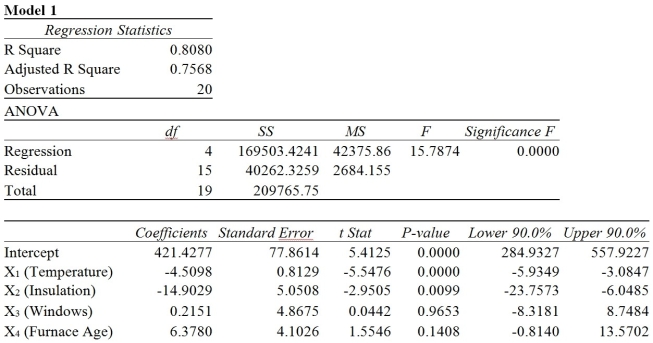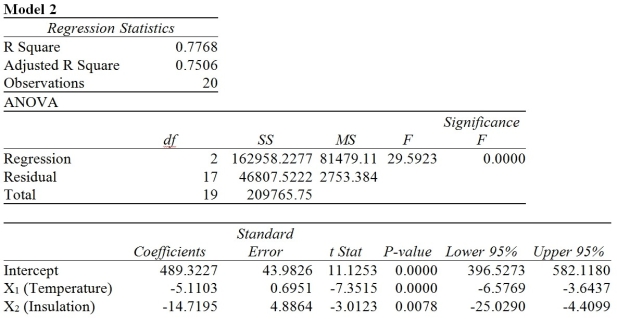TABLE 13-6
One of the most common questions of prospective house buyers pertains to the cost of heating in dollars (Y) . To provide its customers with information on that matter, a large real estate firm used the following four variables to predict heating costs: the daily minimum outside temperature in degrees of Fahrenheit (X1) , the amount of insulation in inches (X2) , the number of windows in the house (X3) , and the age of the furnace in years (X4) . Given below are the Microsoft Excel outputs of two regression models.


-Referring to Table 13-6 and allowing for a 1% probability of committing a Type I error, what is the decision and conclusion for the test H₀: β₁ = β₂ = β₃ = β₄ = 0 vs. H₁: At least one βⱼ ≠ 0, j = 1, 2, ..., 4 using Model 1?
A) Do not reject H₀ and conclude that the four independent variables have significant individual linear effects on heating costs.
B) Reject H₀ and conclude that the four independent variables taken as a group have significant linear effects on heating costs.
C) Do not reject H₀ and conclude that the four independent variables taken as a group do not have significant linear effects on heating costs.
D) Reject H₀ and conclude that the four independent variables taken as a group do not have significant linear effects on heating costs.
Correct Answer:
Verified
Q64: TABLE 13-6
One of the most common questions
Q65: TABLE 13-6
One of the most common questions
Q67: TABLE 13-5
A microeconomist wants to determine how
Q68: TABLE 13-6
One of the most common questions
Q70: TABLE 13-6
One of the most common questions
Q71: TABLE 13-5
A microeconomist wants to determine how
Q74: When an additional explanatory variable is introduced
Q94: When an explanatory variable is dropped from
Q98: The slopes in a multiple regression model
Q100: The total sum of squares (SST)in a
Unlock this Answer For Free Now!
View this answer and more for free by performing one of the following actions

Scan the QR code to install the App and get 2 free unlocks

Unlock quizzes for free by uploading documents